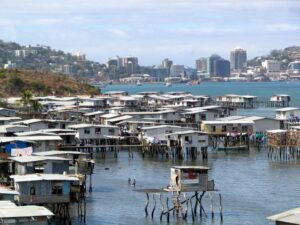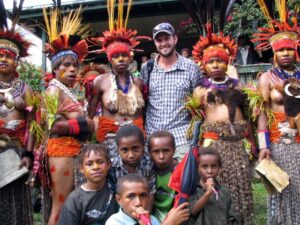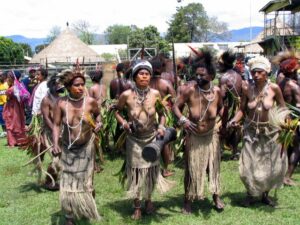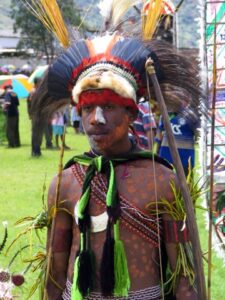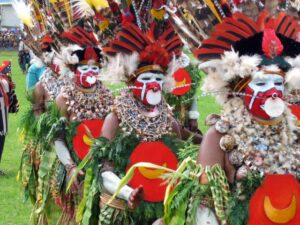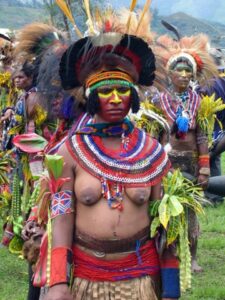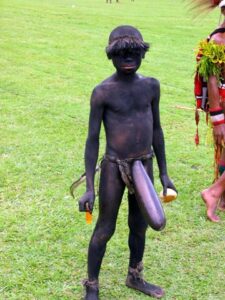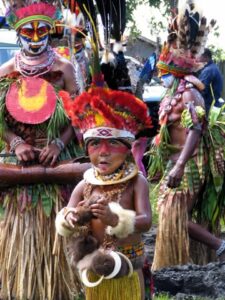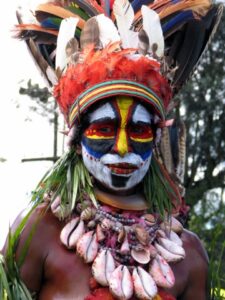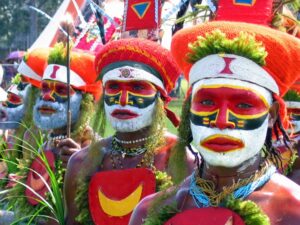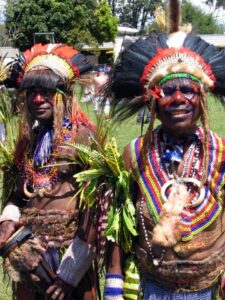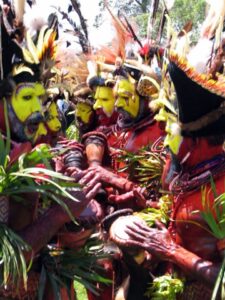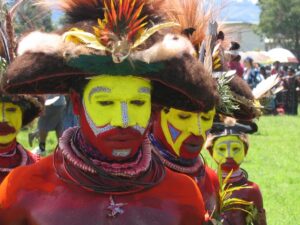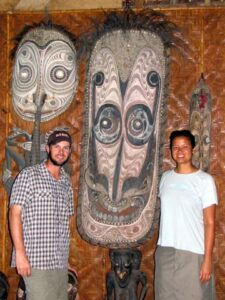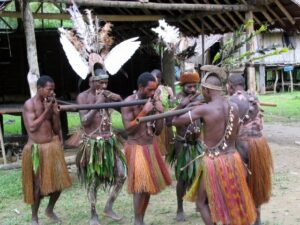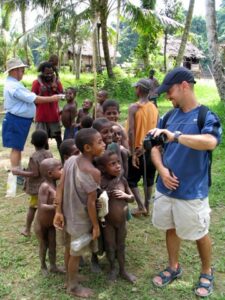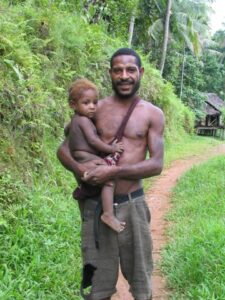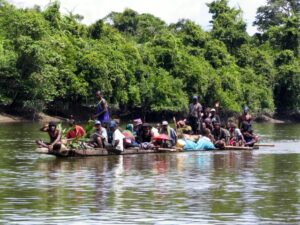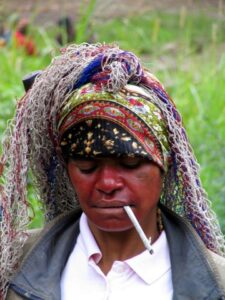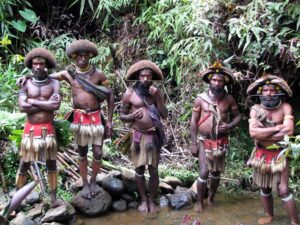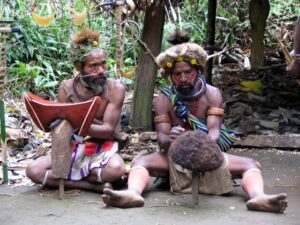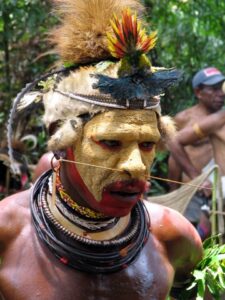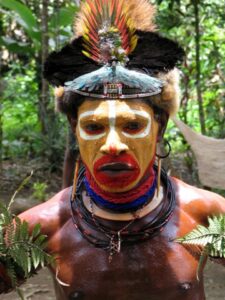We have both dreamt of visiting Papua New Guinea for as long as we can remember, and this finally became a reality for us in the fall of 2005. We heard that the best time to visit was during one of the highland sing-sings, and after a bit of research on the Internet, decided to coincide our visit with the Goroka Show. Prohibitively high prices combined with unnerving news reports of rampant violence in certain parts of PNG have acted as a very effective deterrent, which is extremely unfortunate for PNG. We often heard PNG compared to the islands of Fiji, as both nations started attracting tourists in the 1970s. While Fiji’s tourism exploded, PNG’s remained relatively sheltered, and even today, the annual number of tourists visiting hovers at around 12,000 – 15,000! Compare that to Fiji’s 450,000 visitors per year and you can easily see that PNG has been left in the dust compared to Fiji. We are so glad that we were part of the 12,000 – 15,000 crowd however. PNG has so much to offer, and we were more than happy to take advantage of this rugged country’s pristine beauty coupled with its phenomenal cultural attractions. PNG is one of the most unique travel experiences we have ever had to privilege to experience, and we will definitely treasure our memories for years to come.
The Adventures of the Wantok Clan
We booked our tour with Goway (Mandy Whiteman, mwhiteman@goway.com) who in turn made all necessary coordination with Trans Niugini Tours for a 10 day Goroka Show tour. We later found out how much Mandy had simplified our travel arrangements, and taken care of all the necessary “legwork”. While we made our initial deposit and final payment via credit card, others in our group had to run around figuring out how to make direct payment to a bank in California! Thankfully, we were spared all the hassle, and simply relied on Mandy to take care of everything. We would definitely recommend Goway tours for their impeccable and prompt service…they were absolutely wonderful in helping us organize everything from Afghanistan!
Many services within PNG are monopolies (such as Air Niugini, the country’s only airline). Well, Trans Niugini dominates the market for upscale tours to PNG, and it is owned by Bob Bates and family, an Australian expatriate who has lived in PNG for almost 30 years. There are pros and cons to booking with Trans Niugini…the pros are that you get excellent guides (all of them were very knowledgeable, friendly, and helpful), almost every conceivable issue that arises while on tour has already been dealt with in the past so the staff definitely know how to react to fluid situations (such as revising schedules at the last minute due to “technical” difficulties!), and relationships with the local tribes have been long established so we were greeted like long lost relatives at many of villages we visited. The cons to Trans Niugini are that they are expensive, and some of their equipment is aged and in need of replacement (we had several motor boat issues on the Sepik River, as well as a forced march up the steep hill to Karawari lodge!) But overall, the pros definitely outweighed the cons in our opinion, and we were quite pleased with our overall experience. After all, when in PNG, you must do things the PNG way…and if that means waiting several months for replacement parts, so be it.
This is just a heads up for those demanding travelers who want everything to run like clockwork and expect things to work as they do in the States…get over it! Why go on holiday if you can’t go with the flow when things don’t work out according to plan…we actually had the unfortunate opportunity to cross paths with a very irate woman who was absolutely miserable on her tour. We think she believed it was her mission to make everyone else around her as miserable as she was…thankfully, we only had to deal with her whining and complaining for a few hours in Goroka before we escaped to the Sepik River. We were eternally grateful that our tour consisted of the fantastic 9 (more about our wantok tribe later).
Prior to arriving to PNG, Mandy sent us a pre-departure dossier, which covered all the necessary highlights (key pidgin English phrases, visa requirements, baggage concerns, health risks, cultural sensitivities, currency info, dress code, tipping advice, photography, recommended reading lists, and security concerns). Combined with the 2005 Edition of Lonely Planet’s Papua New Guinea guidebook, we were all set for our trip!
13 September: We flew to Port Moresby from Singapore and arrived at 5:30 am. Obtaining a PNG visa upon arrival is fairly straightforward…just make sure you have 100 Kina handy, as the immigration officials will not accept any other currency. There is a currency exchange just outside of passport control, so if you are in a pinch and cannot obtain Kina prior to arrival, sweet-talk the officials into allowing you to run out to exchange money. We were met by Steven Ipai, the manager of Trans Niugini’s Port Moresby operations. Steven greeted us warmly and ushered us into the awaiting van for our short (60 second) ride to the Gateway hotel…yes, we had asked for “budget” but the Gateway was pretty posh for our needs! Becky was adamant about the opportunity to dive at Port Moresby so Steven recommended the Loloata Island Resort, a private Bootless Bay lodge located 40 minutes from Port Moresby.
Although we had already missed the early morning dive, we were still able to organize two dives. Transfer to Loloata took just under an hour (20 minute drive followed by a 20 minute boat ride). Roaming the gardens of Loloata were crown pigeons and wallabies! There were also several pet tree kangaroos living inside cages, but our focus was on the wallabies as we have never even seen kangaroos in person before, let alone miniature versions!
We met a Japanese lady who helped us sort out our dive gear. Apparently, she visited Loloata Island several years ago, and never left! Such is the allure of island life. Once we were all sorted out, we were taken out to the main dive boat. We met an Australian expat who was supposedly “finding work” while his wife supported his expensive dive habit! We laughed, and wondered if she knew that he was spending the majority of his day underwater! He was still dripping wet from the early morning dive (a WWII wreck which he said was absolutely amazing), so we chatted for a while before the second dive of the day. Diving is reputed to be fantastic in PNG and our first dive did not disappoint. We saw pygmy seahorses (we LOVE seahorses…they are our fav marine creature), hammerhead sharks, shrimp, pipe fish, black tip reef sharks, lion fish, rock fish…great visibility and we emerged an hour lately completely mesmerized. Surprisingly, the water temperature was quite chilly and we relished the warm sun soaking our bodies after the dive. In fact, we enjoyed it so much that we both got extremely sunburned after only 30 minutes of exposure (despite slathering on sunscreen…apparently we needed more!) Our uneven suntan lines brought squeals of laughter from the local children, but we had already vowed to stay in the shade and not prolong the damage.
Our second dive was a wreck dive, and a school of dolphins chased us out to the dive site. The dive was fantastic, and we were truly amazed at the ability of sea life to completely take over a wreck and inhabit it as its own. There were many fascinating specimens of marine life and we could have spent hours underwater. However, after an hour, our time was up so we headed back towards Loloata. And in the nick of time, as rolling clouds swallowed up the sun and torrential rain threatened to downpour. And downpour it did…within minutes we were soaked, but just as suddenly, the weather cleared up and we were left to ponder the fickleness of PNG weather. Loloata was a wonderful diversion for our first day in Port Moresby, albeit quite expensive. 2 dives cost us 220 Kina, along with 120 Kina to rent our SCUBA gear and an 80 Kina surcharge for pickup…when you add all the extras in, it made for a pricey day, although an unforgettable one as well.
Dinner that night was a delicious spread of Indian food at the Gateway hotel restaurant. We had read how bland the local cuisine was (sago is pretty hard to spice up!) so we were pleasantly surprised at our tasty dinner.
14 September: Today was our Sogeri plateau tour, which is one of the more popular Port Moresby excursions. Steven was running a bit late as he had to pick up our police escort. We weren’t sure if the police escort was an optional feature or not, but we were glad once we were on the road and Steven pointed out the “danger” zones of Port Moresby, stating that only the fool hardy would wander certain areas by themselves. The trip out to the Sogeri plateau is only 46 KM, but there are enough sites to keep one’s interest the entire day long. As luck would have it for us, we were on a very tight schedule as tomorrow as Independence Day celebrations in Port Moresby, and as a result, the National Museum was shutting down early. Steven said that was not to be missed, so we hurried along our tour.
He provided a bit of background information on PNG and we were astounded to learn that the country’s inhabitants speak a total of 800 languages! It was very common for adjacent tribes to be unable to communicate with each other! The three official languages are Motu, Pidgin, and Pidgin English. Can you imagine a nation with 800 official languages? And modern day missionaries have undertaken the daunting task of translating the bible into all of the 800 languages, so that the gospel of Christ can reach every last corner of PNG!
First stop was at the Bomana War Cemetery, a very large and carefully attended to WW II cemetery. Over 4000 Australian and Papua New Guinean soldiers are buried here, (the American soldiers killed in PNG were shipped back to the US for burial). Steven told us that the carekeepers used to be locals who let the cemetery fall into disrepair. They were immediately replaced with PNG military veterans who now keep the cemetery in meticulous condition. A very detailed Kokoda trail in 3D is located at the entrance to the cemetery, and it shows the very rugged path that the Japanese soldiers were chased by Australian and PNG soldiers. It is a very steep 96 KM roller coaster of a hike, and has become quite popular with experienced trekkers.
We hopped back into the van and made our way up the Laloki River gorge, which is a windy road offering very picturesque panoramas. Next stop was Rouna Falls, which were pretty impressive despite the ugly hydro electric power plants. We then tried to enter the Varirata National Park, but the staff had already fled the grounds in anticipation of the extended 4 day Independence weekend holiday. With the barrier remaining firmly intact, we had no choice but to turn around and head back towards Port Moresby. Along the way down, we picked up three teenaged girls who gratefully accepted a ride down the valley. Steven wouldn’t pick up the teenaged boys (potential raskols?) but the girls posed no problems. Once in downtown Port Moresby, we rushed to the National Museum, where we were thrilled to see a tribe in costume preparing for an afternoon sing-sing. Steven rushed us onward towards the entrance of the museum and for good reason. The museum carekeeper told us it was already closed, but Steven begged and pleaded and we were finally let in to see the exhibits. The displays on the culture, fauna, ethnography, and history are surprisingly good! And the various cowry shells, masks, shields, and totems are amazing. Too bad we couldn’t take photos inside, as many of the artifacts are quite awe-inspiring.
Next stop was the impressive Parliament haus, which is built in the style of a “haus tambaran”. The entrance facade is particularly impressive, with a mosaic of traditional PNG scenes, atop with scowling masked faces. We tried to enter, but alas! The Independence Day fever already set in with all Government officials starting their weekend early.
We were able to get into the National Botanical Gardens, where Steven promised us that we would get to see the official emblem of PNG, the bird of paradise. The gardens are actually quite good, and we had a picnic lunch there while taking a break from the cassowaries and perfectly manicured gardens. After lunch, we were allowed to enter the enclosure of the bird of paradise, but these very timid birds hopped furiously from branch to branch in an attempt to evade our cameras.
According to our Paradise in-flight magazine from Air Niugini, tomorrow was the start of the Hiri Moale Festival, which is held on Ela Beach of downtown Port Moresby. We asked Steven if we could join in with the festivities tomorrow, and he readily agreed. So we postponed the latter part of our sightseeing for tomorrow and retired to the Gateway hotel where we enjoyed a dinner buffet of Thai cuisine.
15 September: At 0900 sharp, we were greeted by Steven dressed regally in traditional attire for the Hiri Moale Festival! He looked amazing; complete with the flag of PNG adorned upon his face with thick black, white, red and yellow paint. Steven is quite savvy about the ways of the tourists…everyone wanted to take his photo. In fact, Steven has dressed up in past Hiri Moale festivals, and his image has graced the covers of magazines and newspapers worldwide. Little did we know that we were escorted by a celebrity! Once Steven appeared on the Ela Beach, throngs of Japanese tourists ran up to him, stuck their massive lenses in his face and snapped away!
But prior to going to Ela Beach, Steven wanted to make sure we got the rest of our Port Moresby tour so first stop was a brief jaunt at the PNG Arts emporium. A visit to this massive souvenir shop is a must, if only to get an idea of the vastness of souvenirs available in PNG. We found several amazing masks that we calculated on buying upon our return (we should have put them in layaway since they were scooped up during our 10 day absence). But ignorance was bliss, and we had more than enough masks to choose from.
Next stop was Hanuabada, which is an original Motu village. Houses are still built over the water on stilts, and while the original wooden houses were destroyed during WWII, the “new” ones were built with Australian-provided materials. Steven’s wife is from Hanuabada, so he was warmly greeted wherever we went (once folks recognized him beneath all the face-paint that is!). Paga point was the next brief stop, offering fine views of the harbor and beyond. Steven cut his foot on a piece of glass, which is a good reason not to wander around barefoot like all the locals do.
Ela Beach was rocking by the time we arrived, but Steven simply pulled up on the curb and parked his van there. The policemen all knew him and looked the other way. The Hiri Moale festival was in full swing, with replica giant Papuan trading canoes parked just off the coast. The official participants had to wade the rest of the way in (careful of painful sea urchins), and a large crowd was gathering on the beach. The first thing we noticed was that all the female dancers were bare breasted. After dance performances on the Cook Islands, Fiji, and Tahiti, we had seen plenty of island-style dancers, but none who had been au natural before! What was truly special was no one was making a big deal about it…no gawking, no cat calls, and no disrespect. We had timed our visit well, and were in time for VIP seats to watch the opening speeches by the political dignitaries. Afterwards, the “Miss Hiri Moale” contest was in full swing, and we were graced by the promenades of Miss Hiri Moale 2004, as well as 16 contestants for 2005. The young ladies were quite beautiful in their traditional costumes, and we can easily see why so many foreign men come on vacation here, fall in love and never leave!
Time was short so after 2 hours at the festival, Steven took us back to the Gateway hotel to check out and catch our flight to Goroka. We had no problems checking in and were ushered into a large waiting area where all the Air Niugini flights were consolidated. We actually had to strain to hear which flight was being call and for where. Pidgin English takes some getting used to, but we were able to make our way onto the correct flight! Goroka was pouring down with rain by the time we landed. We retrieved our baggage, and were met by Lawrence, our local guide.
Lawrence hailed from Mount Hagen, and he was a very friendly fellow who always tried to make the best of any situation. He informed us that there were 2 others joining our tour from the same flight (Richard and Roberta) and that we had to pick up 2 more passengers (Jan and Suki) from the Bird of Paradise Hotel. The 6 of us would be transported to the Kainantu Lodge, which was located a long 2 hour drive away. Since darkness was upon us, a police escort had been arranged. During the bus ride, we found out a little bit more on our fellow travelers.
Richard and Roberta hail from California. Richard served in the Air Force during the Vietnam War but had gotten out and was a doctor. He dispensed handy advice on our many physical ailments throughout the trip (how to treat diarrhea, bites, bruises, etc). Roberta was involved in the “industry” (she claimed that everyone from LA knows what that means) and had been involved in a Canadian beer commercial. Roberta and Richard are very proud grandparents of their CA and NY based grandchildren, making them “bi-coastal”. Amazingly, they had been married to each other for 43 years, and PNG was a destination high on their circa 1986 to-do list. They never discussed presidential elections (or who voted for whom) with each other in 43 years of marriage, and it appeared to be the secret of their success!
Jan is Dutch, but is lucky enough to have joint domicile in Boston and London. He is by far the most well traveled individual we have ever met, spending 80% of the year traveling to various destinations! We can only strive to match Jan’s intrepidness and willingness to explore the unknown. He gives us plenty of new destinations to add to our “must visit” list and we can’t wait till the day that he decides to post his meticulous travel notes and photos online!
Suki is a physician’s assistant based out of Ohio. She has paired up with Jan on several exploratory trips in the past, and is an avid trekker who loves the outdoors. Suki revels us with stories of being one of the first explorers in remote sections of the Irian Jaya (Indonesia’s “Wild East”), telling us how she climbed up a tree hut to see a woman breast feeding a piglet in a smoky room…absolutely amazing stories. She is forever picking up incredible finds along the way, and we tease her when she buys two beautifully carved oars and attempts to lug them back home! Even more astounding is the fact that she gets away with it, so we quickly learn that Suki has done this before and knows exactly how far she can push the souvenir hunting!
We introduce ourselves to the rest of the group who wonder what two crazy individuals are doing in Kabul, Afghanistan. But after we assure everyone that we really aren’t secret-spy, CIA material, we all turn our attention on the increasingly windy, road and the ensuing darkness that gradually encroaches upon our bus.
Dinner at the Kainantu Lodge is pretty good, and we explore our “suite” after dinner to discover that bigger isn’t always better. It just allows for more room for the roaches to dance across! Seriously though, our room had many creepy crawly visitors, but what can we expect? We are in the highlands, and our room is on the first floor where all creatures will inevitably seek creature-comforts such as heat and dryness! We toss and turn for a not-so-decent night of sleep and look forward to the opening ceremonies of the Goroka sing-sing show tomorrow. Lawrence had provided us with Goroka show tickets and informative pamphlets, which fuel us with plenty of anticipation.
16 September: We had all agreed to leave the lodge at 0715, but in PNG time that equated to 0745. We were pleasantly surprised to have 3 additional travelers join our group, bringing our total number to 9. Gene had agreed to pay for the trip for his son, Scott, and daughter, Shani. We quickly found out more about the happy trio.
The first thing we notice about Gene is his infectious laugh…he has a bubbling personality that spills its contagiousness to the rest of us. Gene had greater insight into the Kainantu Lodge versus Bird of Paradise hotel fiasco from his friend Greg in California (Greg told him that due to a political battle, the Coral Seas hotel chain, which included Bird of Paradise, decided to “bump” all reservations made by Trans Niugini since Trans Niugini reciprocated by only allowing its customers to stay at the lodges at Karawari, Ambua and the Sepik River. It was a tit for tat situation, and unfortunately we were caught in the middle). Gene hails from Santa Barbara and knew a lot about boats (hence he came in VERY handy during the Sepik river boat crisis in identifying what the problem area was…too bad the replacement parts weren’t on hand as that would have resolved most of our technical difficulties!) Gene impressed us because he has visited over 50 countries and is very well traveled. As well as generous…we know that neither Scott nor Shani will forget this trip of a lifetime!
Scott is also from California, and he left behind his beautiful wife and two daughters to join us on this trip. He works for Intel and was given a tri-band cellular phone, which he uses in a desperate attempt to make an international call home to the family. Believe it or not, PNG doesn’t allow outgoing international calls so Scott is incommunicado with the family for a few days! He is lucky enough to work from home, and gets to spend a lot of time with his family, whom he obviously misses because he often looks up their photos on his phone. Scott doesn’t have much technological luck on the trip, as his Nikon SLR digital camera goes on the flux at random times throughout the tour! Nevertheless, Scott is a trooper and doesn’t let much get him down.
Last but not least is Shani, who is an adventuress willing to explore the world on her own. She amazes us when she tells us of the past 72-hour odyssey she embarked in coming to PNG. First, she competed in a triathlon, and then immediately drove 7 hours to catch her flight, which went from California – Brisbane – Cairns – Port Moresby – Goroka. In every village that we visit, the children point to her tiny feet and laugh hysterically. Some of the more daring even stick their feet out next to hers in comparison! Scott describes her shoes as those that fit on a key chain! Despite her petite size, Shani packs a punch and is definitely able to hold her own amongst Gene and Scott, whipping them into top form throughout the tour.
Ok the answer to the question all our guy friends are asking is YES, Shani is single and would make an awesome catch for the adventure-seeking guy. Ok…moving on for the rest of our action packed day….
We were jostled along the 80 KM route from Kainantu – Goroka and finally arrived at 10 am. After a quick pit stop at the Bird of Paradise hotel, we head towards the main fairgrounds and discover that the tribes haven’t made their way to the venue yet. So Lawrence suggests that we drive around in search of tribal participants who are still putting together their make up and costumes. We don’t have to look far to discover our first tribe, who adorn their entire bodies with long blades of grass, which is topped off with sailboat-shaped hats. Lawrence asks for their permission for us to witness their preparations, which they readily agree to. We are fascinated by this tribe, and eagerly snap up photos for posterity. After they put on a sing-sing show for us, they make their way to the fairgrounds, but another tribe marches through so our attention diverts to this new mixture of vibrant color and sound. What a prelude for the rest of the day! We have never seen such performances (sing-sing) in such close proximity before. The tribes all graciously put up with our overeager enthusiasm, while boiled over as the day progressed and we saw tribe after tribe proudly march into the stadium grounds. Today was an anthropologist’s delight…we cannot possibly describe the sights and sounds in a way that would come close to reality. Suffice it to say that after several hours of being able to freely mingle with all the sing-sing tribes, this rates as one of the best one-on-one exposures to a foreign culture. Absolutely unforgettable and definitely worth every penny we spent on this trip!
Just a bit of background history for those of you who don’t know (most of this info came from my circa 1993 Lonely Planet PNG guide) A sing-sing is a celebratory festival or dance that is coordinated several times a year. Although it is not an everyday occurrence, it is a must for you to try to see if you are up in the highlands! Around Hagen they are still quite frequent, but finding where they are and getting to them can be a problem. Many parts of the Highlands are still inaccessible to vehicles, and sing-sings are often in remote areas. A sing-sing can be held for any number of reasons – it might be associated with paying off a bride price, a moga ceremony or even some more mundane activity like raising money for a local school or church. Whatever the reason, the result will be much the same – a lot of people, brilliantly costumed, singing and dancing. Take plenty of film if you are keen on photography!
The Highland Shows (Goroka or Mount Hagen) are two of the best. During the 1950s, as the Highlands first came into serious contact with Europeans, the Highland Shows were instituted as a way of gathering the tribes and clans together and showing them that the people from across the hill weren’t so bad after all. They were an amazing success and grew from the original concept of a local get-together into a major tourist attraction. As many as 40,000 warriors would gather together in the show arena in a stomping, chanting dance that literally shook the earth. Drums thundered, feathers swayed and dancing bodies glistened with paint, oils and pig grease. It was like nothing else on earth. Unfortunately, the shows have suffered a serious decline. The Highlanders are increasingly sophisticated, so the curiosity value of the gatherings for the participants themselves has waned, along with their pride in their traditional finery. In addition, with better transport and improved roads, it is no longer such an effort to get from place to place, so people don’t need to save up for an annual gathering. Still, the shows do go on, and you won’t be disappointed! The Goroka or Mount Hagen shows are still one of the best available opportunities to get an overview of PNG’s extraordinary cultural diversity.
We estimate that there are about 30 unique tribes stomping and chanting at the showground today, and many of the tribes have over 30 members! It all makes for a colorful barrage that assaults all of our senses until we have sensory overload and simply cannot comprehend the vastness of it all. We try to capture as much of the sing-sing on film, but it simply does not do justice to what we experienced. The statement that there is nothing else like it on earth definitely rings true for us today!
As soon as our group gathers together for lunch, we compare notes and pinch ourselves to see if we are dreaming. However, storm clouds roll in shortly after 1:30 pm, and the participants flee from the rain (the thousands, if not millions of feathers adorning their fabulous headdresses will get ruined, and they are VERY hard to come by). Nevertheless, we leave the fairgrounds satiated, and look forward to repeating this process again tomorrow.
Some of our personal favorite tribes included: all the Mount Hagen tribes (male and female), Mud-Men tribe, the Jail-Birds, and the young boy covered in black wearing the massive penis-gourd…absolutely hilarious and unforgettable! He came up behind Becky and stuck it out during a photo session, causing us to laugh hysterically…and yes, the penis gourds do make a very popular souvenir!
Afterwards, we collected our senses and decided to do a bit more sightseeing within Goroka, so we headed towards the Goroka Raun Raun theater. This theater was quite a surprise…built entirely from wooden logs, it was a massive building whose combined effect was quite traditional and modern! The theater was being used to celebrate Independence day (with birthday cake and all), and one of the celebratory men profusely thanked us for coming to PNG and urged us to spread the word about his lovely country.
Next stop was the JK McCarthy museum. The museum is pretty small but worthwhile for a quick visit. The most grisly display pieces were necklaces with human fingers on it! There were also some very good photos taken by Mick Leahy (of the Leahy brothers fame in the 1983 movie “First Contact”) Mick was the leader of the expedition that discovered the Highlands in 1933 and the movie is a fascinating insight to how the local tribes received his entourage, with much of the footage taken firsthand by Mick.
We made our way back towards Kainantu, where we were pleased to find out a buffet dinner was on spread. We were ravenous and tried the taro and banana (both are very starchy, with the banana tasting more like a potato than anything else!), barramundi, pork, and amazingly, apple pie with vanilla ice-cream for desert.
17 September: We had all agreed to get up early so we could get to Goroka on time. The 2 hour bus ride was getting old though! We had to convoy with another bus and a police escort, and along the way the lead bus (not ours) struck and killed a pig. We had quickly learned how taboo that is, and watched in amazement as the bus charged onward, without stopping to make due compensation. Killing a large pig demands compensation of 1000 Kina or even higher!
Just a bit of background information on how valuable pigs are in PNG society. They are extremely valuable animals that are often used in payback for bride prices, and tribal wars often start because of pigs! They are regarded as family members, and lactating women sometimes suckle piglets. All around PNG, we’d see people taking their pig out for a walk on a makeshift leash, and pigs are used to help farm and for the women to snuggle with at night inside the house (yes, according to our LP guidebook, due to superstitious beliefs in the Highlands, women are traditionally distrusted by men. The men go to extraordinary lengths to protect themselves and maintain their status. Sexual relations are not undertaken lightly – contact with women is believed to cause sickness and men usually live in separate houses and prefer to cook their own food!) Pigs do provide women with some form of companionship that they do not get from their own men.
We asked Lawrence how this situation would be handled, as we did not want to face an angry crowd later that night on the long bus ride home. He said that compensation would be met (but it was better for tourists to not be present as that would drive the prices skyward!)
Once we reached Goroka, we headed directly for the showground, and were able to watch as the tribes all marched in with their splendor and glory. There were a lot of police enforcement who prevented all locals from entering the showground, but as soon as they saw tourists, we were beckoned in. Later we found out that we had unadulterated freedom for about 2 hours to interact with all the sing-sing performers before the gauntlet was released open and everyone could storm the parade grounds. In a sense, we really did feel bad that the locals were prevented from participating in a show that was really for them, but Lawrence explained that most tourists spend a fortune to get to the Highland sing-sings, and it was decided by local officials that this expense would be honored by allowing us special privileges.
Once again, we were mesmerized by the sheer number of tribes participating in the show, as well as their phenomenal costumes, songs, and dances. Truly brilliant experience, and there were some newcomers that were not present yesterday. We spent hours photographing to our hearts content before taking a quick break for lunch. Just like the day before, the sky turned nasty and rain down poured on everyone with almost no prior warning. This time, the rain meant business, so the tribesmen and women bombarded the only covered canopy on the show ground (which was where we had been enjoying our picnic lunch). Everyone crowded in to protect their feathers from the devastating rain, and it actually made for a very unique backdrop for some awesome photos of tourist interacting with tribe!
Our favorite tribes today were the Huli Wigmen (absolutely amazing chants and incredible wigs…more on their wigs when we get to Tari), Mt Hagen’s marching warriors (truly a fearsome sight to behold), and the tribe painted in black with bald heads and bows and arrows (who constantly mock-grabbed their crotches and giggled)
We had agreed that today we’d take a dip in the Bird of Paradise hotel’s pool following the culmination of the day’s performances. However, while waiting to depart the showground, we met another Trans Niugini group who was throwing an absolute fit because they weren’t getting their way! We are embarrassed to admit that some members of their group were acting in the stereotypical “ugly American” way that gives other US travelers such a bad rap in many parts of the world. Apparently, their party of 10 was told that they’d have to put 8 pax into a mini-van, and split off 2 into the other two buses. They demanded that our group of 9 switch vans with them, because our van was a bit bigger and would allow for them to store all their luggage with them. We were quite ready to acquiesce, until we heard more of their demands and realized that no amount of kow-towing would satiate them. Finally, Gene stood up and refused to cater to their ever-increasing demands. Why should we have to split up our group just to satisfy them? Their response was classic, “because they had spent a bloody fortune on the trip and they were a private group who didn’t want to interact with anyone not part of their tour, and why should they be inconvenienced….”. Well, you can imagine that after that flimsy response, our 9 member band decided not to budge, and we stubbornly refused to trade vans, although we did invite anyone who was willing to join our group since we had a few spare seats. An angry argument ensued, with the final outcome of us winning the dispute. So we headed over to the Bird of Paradise to celebrate with some swimming, beer, and pizza and laughed about how we probably ruined some high-maintenance tour group’s day.
After a few hours, we were ready to hit the road, and guess what!? The demanding group that refused to be separated from their luggage for fear that we would rifle through their precious cargo had loaded it onto our bus while we were busy downing a beer at the bar! Too funny…and now we were about to make them mad since we didn’t go directly back to Kainantu but hung out for several more hours in Goroka. We all laughed at the ridiculousness of the situation, and Shani suggested that we name our 9 member tribe the “Wantok Clan” (after the “wantok” pizza we had just consumed), since we had bonded so well in the face of adversity.
Later on, we found out what wantok meant, and realized that we had chosen a very befitting name for our clan! “Fundamental to Melanesian culture is the idea of wantoks (meaning “one talk” in Tok Pisin), and your wantoks are those who speak your language. Within the clan, every person can expect to be housed and fed, and to share in the community’s assets, essentially bonding all tribe members as one family who shares all possessions equally amongst each other”. What is even funnier is when we walked into the Karawari lodge, there was a sign in every room that said, “Welcome Wantok”!)…how ironic was that? We all had a good laugh when Scott mistakenly called our clan the “Mewok” tribe, which reminded us of Star Wars and made us laugh out loud.
18 September: We could not leave Kainantu lodge fast enough. Our breakfast was ruined by the so-called ringleader from yesterday’s battle, who kept emphatically telling every member of her group to pack their bags, cause yes, they were leaving today and to hell with no accommodation in Goroka, they’d find something or else drive all the way to Mt. Hagen. Her one comment that made us choke on our breakfast was “I’m not fussy”….we just laughed and got out of there as fast we could. That goodness Ms. High maintenance was not part of our group…we all would have pitched in to throttle her by now!
Today, we were headed for Karawari, which would be a lot steamier than the Highlands. Our luggage was restricted to 10 kg each, and we wondered how big (or how small) the plane would be! At 0830, we were in Goroka, and saw the tiny plane touch down on a special runway. Unbeknownst to us, our friendly pilot was Bob Bates, the owner of Trans Niugini Tours! He was dressed like the average Joe and only introduced himself as “Bob”, so we never knew the difference. We posed for a group photo, before we split our group into two (Gene, Shani, Scott, Becky, and Robby on the first flight, with Jan, Suki, Roberta and Richard catching the second one) since the plane was a 6 seater (including the pilot). We shoved our luggage on board the tiny Beachcraft Baron (built in Wichita, Kansas) and were on our way. The views from up high were amazing, and it only took an hour to reach the tiny grassy landing at Karawari.
Immediately upon landing, we were caught in a sweltering heat, which caused us all to strip down to almost nothing! We were met by Michael (a very friendly Nepalese man who had been living in PNG with his wife, Manu, for over 15 years), who walked us through a small clearing to our boat, which would transport us to Karawari lodge. A short while later, we reached the steep river banks of our landing, and had to scramble up the muddy steps. The jeep’s engine was acting up, and we knew something was up when Michael innocuously asked us if we’d like to go on a “short walk”! We all agreed, and sweating profusely 10 minutes later, realized that we were walking up the hill towards the lodge. Shani was funny; she got behind Gene and literally pushed him up the steepest parts of the hill…such is daughterly love!
At the top of the hill, we saw a haus tambaran, (also known as a spirit house), which had an amazing Gable Mask. Manu greeted us with cold, refreshing towels and delicious glasses of freshly squeezed lemonade. It made the walk uphill worthwhile! We agreed to wait until the rest of our clan joined us before getting a briefing on what our agenda was today, and Manu showed us to our rooms. The Karawari lodge had magnificent vistas overlooking the Karawari river, and we could easily see why this location was chosen for a jungle-resort.
Our wantok clan was reunited in time for lunch, which was delicious. We knew we’d be spoilt with our food here, and looked forward to many more good meals. Immediately following lunch, Manu gathered us in for a quick briefing inside the lodge. The Karawari lodge itself is like a museum…many oversized quality pieces belong to the Bates family, and they tastefully decorate the entire room. Manu gave us a brief history of the lodge: created by sago (miracle palm) leaves and Kiula wood, and the garamoot drums would be bonged to signal our meals. Crocodile-carved tables were a popular motif, since the crocodile is believe to be a good spirit, which brings fish to all the villages. Indeed, we would later find out that the Crocodile clan (along with scarification) is quite popular in this area. The Karawari lodge itself is known as a museum of Sepik art and culture. Everything about the lodge itself is culturally Sepik, with the primary lodge in the shape of a spirit house.
We met Bonnie, our tour coordinator who had arranged a village visit for us this afternoon. It was a short boat ride across the river to see what Sago was all about. Called the sak-sak, sago is the staple food along the Sepik river (as well as other swampy areas of PNG). It is pure starch, and is commonly eaten as a pancake or glutinous porridge. A demonstration was put on by the local villagers on how sago is prepared.
First, one of the village men brought us to where the sago palm had been cut down. He stripped away the bark, and pounded out the pith, transforming it into a fibrous sawdust material. A village woman then collected the fibrous material and kneaded it in a bark funnel down by the river. She drained river water through the pith to dissolve the starch. The starch laden water is collected in an old canoe, and the starch settles in an orange, gluey mass at the bottom of the canoe. Afterwards, we gathered to see the ladies transform this gluey mass into something edible, and sure enough, pancakes and porridge emerged a few minutes later. We were offered some to taste, but it was rather bland, kinda like a thick-sticky, gummy, plain tortilla. A whole lot of work for some pretty simple fare. We joked that the village kids should know what they were having for dinner tonight!
Afterwards, Bonnie took us for a short walk in the woods. He identified several wild indigenous plants we should keep an eye out for, and then we headed back to the lodge, where popcorn snacks were enjoyed with a beer or two before dinner. The sunset tonight from the lodge was really colorful, with the sky turning twinges of pinks and purple, before finally descending into complete darkness. Dinner tonight was truly lovely, starting off with ginger soup (Becky HATES ginger but loved this damn soup…the chef really was wonderful), and barramundi fish. Desert was a syrup coated banana, topped with whip cream…delicious! We were amazed that we could be spoiled like this in the middle of the Karawari river…but such is the nature of Trans Niugini tours.
19 September: We had a 0530 wake up call so that we could go bird watching, and maybe be lucky enough to catch a glimpse of the very rare 12 wired Bird of Paradise. Manu told us that a National Geographic photographer had based himself out of Karawari lodge only a few weeks earlier, where he managed to take some amazing photos of the rare bird. He built a perch next to a tree where the bird of paradise was locked into (apparently, there are many definitions to the word “lock”…when birds habitually roost upon the same branch of the same exact tree, that is also called a lock, as Suki patiently explained to us. Meanwhile, we drove her batty while venturing out our own haphazard guesses at to which lock she was referring to…a lock of hair, a lock on baggage, the Panama canal’s locks, etc)
Despite the early morning hour, everyone was fairly cheerful after a cup of coffee or tea was provided. It was a short boat ride to the area where we’d have the most luck seeing the bird, and sure enough, at exactly 0600, it swooped overhead and landed on a perch 300 meters away. Of course we had to squint to see it, but after a pair of binoculars was passed around, we could make out the faint outline of the beautiful and endangered bird of paradise. Note: Bird watching is very tedious and patient work…not much of a reward for so much effort…but we did enjoy our early morning venture if only because we witnessed a brilliant sunrise that painted the sky a series of blues, purples, reds, and pinks. Other birds that flew by included the hornbill and white bellied eagle. At the Karawari lodge, we also saw colorful green and red parrots screeching about loudly.
Poor Shani was not in top form today, and she vowed to drink only bottled water from here on out. So we left her in the able hands of Manu and took off with Bonnie for an action packed day. He informed us that we would visit several tribes around the Karawari Lodge and Yamas Lake area, to include Amungari, Tanganigit, Yimasin, and Yimas villages. These traditional villages along the Karawari and its tributaries (Yimas and Konmai rivers) were touted as a great place to see, feel, and learn about the normal, daily life of its people.
First stop was a Amungari village, where we witnessed a traditional flute ceremony. Trans Niugini Tours has historically coordinated many village visits in the past, so when the local villagers hear the running of an engine motor, they run off to don their traditional sing-sing attire. Apparently, they do get financial compensation for performing re-enactments of their traditional dances, but it is a bit staged. However, if all of these arrangements hadn’t been pre-organized, we would definitely not have seen as many of the traditional customs as we did…so in a way, it’s a good thing that Trans Niugini provides financial compensation, as it serves as a great incentive for local tribes to keep their traditions alive and pass them on to the next generation. The women who weren’t participating in the flute ceremony ran to get clothes to cover their breasts, while the young children ran gleefully naked down to the riverfront to greet us. After the flute ceremony, the locals laid out their masks, drums, bows and arrows, and bilum bags for sale. This process repeated itself at every village, and it was a great way for us to stock up on smaller souvenirs along the way.
Bonnie described the one legged Yipwan cult, a figurine we’d see over and over again during our village visits. All the major anatomies are carved into the simple figure, and we figured it was a bit too morbid to bring home as a souvenir.
Tanganigit village was our second stop, and the children were doing daring jumps into the river to entertain us. Today, we would learn how the local tribe here caught wild pigs. They took us into the forest, and showed us the ingenious (and effective) wooden staked trap that is used to catch the pigs. Basically, the pig is lured into the “cage” by some food, and once it triggers a hidden trip wire, the cage door comes crashing down. It seemed effective, and we can imagine many a pig caught this way!
Bonnie hails from the Yimasin village, where we made our third stop. We were invited to walk into a traditional house, and it was a bit scary to walk inside it! We weigh a hell of a lot more than the locals do, and the sago palm bark flooring seemed to sway a bit too much for our liking. Nevertheless, it was nice to see the inside of our wonderful chef’s house, and we marveled at its simplicity. Everyone sleeps on the floor of the house, and there is very little clutter adorning its simple walls.
Roberta found a beautiful Kina shell necklace, which she bought for a reasonable price (note: there is first price, but always ask for second price if you are truly interested in purchasing an item…Bonnie helped with negotiations, and Roberta ended up with a truly beautiful piece).
We hopped back into our boat, and took a slight detour into Yamas lake, where we turned a corner and saw beautifully ornate women, dressed to the hilt in face paint, Kina shells, and grass skirts, pull out fish from the river. It was way too staged, as we looked from woman to woman, who gleefully pulled out multiple fish snagged on the same line. The funny thing was, these fish had already been cleaned and gutted, yet they were hooked at the end of the fishing line. We started laughing, and took their posed photos anyway, perhaps leaving Bonnie’s feeling a bit miffed since he had gone through all the trouble to show us the way the local women “catch fish”…our reaction wasn’t quite what he expected!
Lunch was pretty simple, and we had the view of Yamas Lake and Susan’s Mountains in the background (Susan’s mountain gets its name because its shaped like a pair of women’s breasts). Afterwards, we headed over to see Bonnie’s lake house, which he uses when he is serious about catching a lot of fish. We were pleasantly surprised to see his neighbors, who excitedly called us over to tell us that they had caught and killed a wild pig. Their mangy dogs were circled around the kill, and they looked pitifully small, just a bundle of fur and bones. But Bonnie explained that if the dogs are kept hungry all the time, they are more aggressive hunter. Richard hopped in a canoe and was taken for a short ride, and Bonnie told us a WW II story that occurred on Yamas Lake.
Yimas village was occupied by a platoon of Japanese soldiers during WW II. There was an Australian coast watcher by the name of Captain Blood who was also in the area. One day, Captain Blood was paddling his canoe when 5 Japanese soldiers fired upon him. Blood managed to evade the bullets and he threw a hand grenade towards the Japanese boat and sunk it. 4 of the soldiers were killed instantly, and 1 of them swam away. 45 years later, Yimas villages caught a giant crocodile using a fishing net. Inside its stomach was a Japanese army boot and a wrist watch…thus solving the fate of what happened to the fifth soldier! The massive head of the crocodile can still be viewed on the bar at the Karawari lodge.
Our last stop was at the Yimas Namba Wan village, where we climbed up a knoll overlooking the Yimas lakes. On the knoll stood an old haus tambaran, where 50 years ago, traditional blood stones were still in use! Enemy tribesmen were tied to the stones, and had their heads chopped off…the Yimas people believed that this gave them more power. Thankfully today, all that stands atop the knoll is a simple school, where the children of the village receive an education. Climbing back down the hill, Bonnie pointed out two Japanese bunker tunnels, which have long been filled with trash and weeds.
After our full day excursion, we headed back towards the lodge on a trip that should have taken 90 minutes. Just as the lodge was in view, our boat’s motor shuddered its last gasp, and we came to a standstill. Then, as the Gods would plan it, the skies opened into a torrential downpour that quickly soaked the outside perimeter in a sudden gush of heavy rain. When we looked off in the distance, we could see that the rain had stopped, so it appeared that a merciless trick was being played on our boat, with a constant rain cloud following our every move. Finally, the rain abetted, but now we had the daunting task of tackling the muddy embankments to reach the lodge. Somehow we managed to do it without slipping (which is VERY easy to do), and we reached the serene calm of the lodge to dry off and change before dinner.
While we were lounging in the lodge awaiting the dinner drum to be sounded, a lanky red-head sauntered in and introduced himself as the captain of the Sepik Spirit, “Big Red” AKA Nathan. He was hilarious, and had us rolling with laughter…we definitely see potential in Nathan to become a stand-up comedian. He introduced himself by telling us that he recently been the only white boy in town who was invited to a local sing-sing dance competition. Not one for being shy, he went full out and ended up winning the dance competition, earning the coveted 20 Kina prize. The way he described it, we can certainly picture him dancing with full gusto, and teaching the locals very obscene dance moves…we can only wait to see if future generations incorporate Nathan’s dance moves into theirs!
Dinner tonight was equally as good, consisting of pumpkin soup, beef and desert. Boy, were we getting fat on this trip! We definitely have no complaints whatsoever about the food that we were getting. After dinner, we stayed up and talked politics with Manu, Michael, and Gene, before finally calling it a night.
20 September: After breakfast, we checked out at 9 am, but not before a mask-buying frenzy occurred! The lodge’s best pieces were scooped up and wrapped, and we headed down the hill to board the Sepik Spirit (after hearing that her engine had indeed been fixed!). We said goodbye to Michael and Manu (2 gracious hosts), and were met by Nathan who gave us a hearty welcome on board and informed us that this would be his last cruise (he was moving on to cattle ranching in Australia for his next gig).
Our goal today was to head up towards the Sepik River, which meanders through a huge area of 78,000 square km. Sepik art is supposedly the world’s finest primitive art, with inspiration from recording a spiritual and ancestral history of communities in pictorial form. The artists attempt to do this by explaining it in the best possible light. All we know is we found the art to be amazing, and wanted to pick up just one unique piece to bring home for a souvenir.
After lunch, we headed out to see how the fishermen preserve their fish. It is done by a smoking process, which allows the locals to store their fish for up to 6 months. We were then supposed to return to the Sepik Spirit before heading out towards our second village for the day when Joe, our guide, broke the bad news to us. Our motor boat (the same one that was having engine problems yesterday) was not going to cut it, and we’d have to cancel our afternoon excursion and try to make it up on the return trip home. We were pretty disappointed, but with engine problems, what can you do?
So we simply relaxed on board the Sepik Spirit, and ordered beverages from the bar (yes, Nathan was also an accomplished bartender who saw to our every needs). After dinner, he put in a video that promptly put half our clan to sleep! (Nathan definitely learned his lesson, because after the first night, no more videos were ever offered to us again!)
21 September: Joe briefed us that we would have a fairly packed schedule today visiting 3 different Blackwater tribes. Apparently, our boat’s oil filter was replaced, and we would have no problems sticking to our agenda. After breakfast, we got our cameras and bug spray and were all set for a full day on the Blackwater Lakes.
Village number one was Mameri, where the Yapmul tribe resides. Our guide, Joe, was from the Mameri tribe, and he showcased off his very neat and organized village to our group. We were most impressed by the nice gardens, segmented off neatly by “pots” made of bark or bamboo. Small crocodiles were kept in a tiny enclosure, and we were able to peer into the compound and gaze at these pitiful creatures. One section of the village was bustling with local families running out to display their wares for sale…masks of all shapes and sizes, flutes, wooden carvings, bilum bags, and kina-shelled jewelry. We wandered around checking out the huge selection, but ended up just taking photos for souvenirs, as we didn’t want to weigh ourselves down with extra baggage just yet. Afterwards, Joe invited us into a cordoned off area, where a flute-show was put on for us.
Yesimbit was our next stop. The Kabriman tribe lived here, and we had a hell of a time getting in to see the tribe. Our boat brought us as close to land as possible, and we had to walk across crocodile-carved canoes to reach land. It was a careful balancing act, as the canoes are very narrow and prone to tipping over! Joe led us through the village, and again, there was a vast selection of Sepik River carvings for us to choose from. We were able to visit the sacred men’s house, where the bottom floor had been converted into a showcase of various carvings, food hooks, and masks for sale. We ended up buying a very simple food hook here. Afterwards, we ran into a very young child who was absolutely horrified at our presence, and his panicked wailing caused immense laughter from the other tribal children. Indeed, every time one of us would stop to give a friendly wave or to smile broadly at the boy, he squealed in fear and convulsed with repulsion. It was the first such reaction we had experienced thus far along the trip, and we wondered if it was because tourists were such a rarity in this area. The Kabriman tribe decided to share its scarification war dance with us. This war dance is traditionally done after the successful execution of a headhunting expedition. The biggest highlight from this dance was the display of scarification on several women dancers. Their entire backs had been cut and stuffed with mud, which caused an eruption of the skin into an enflamed welt. There were many welts on the back, which formed a unique pattern similar to a crocodiles back . Obviously this process must cause immense pain, and yet the women seemed quite proud to display their scarification marks for us. We were told that only a handful of the Kabriman women were adorned with scarification, as it indicated that they were the mid-wives and could assist with the birthing process.
We pulled into a shady area for lunch, and soon became fascinated with the fish lurking beneath our boat. So we lured them to the surface by throwing pieces of our lunch (bread, corn, chicken, the works!) and the fish would immediately gobble the tidbits. Obviously, the Blackwater tribes do not suffer from lack of food…the fish here bite at just about everything!
Our last tribal visit of the day was to the Tungimbi village, where we were dazzled by its amazing spirit house. This haus tambaran was very large, and still functional. An ornate gable mask was mounted at the top of the entrance, and we were advised to remove our hats inside the spirit house. Joe gave us some free time to explore the ground level where a massive display of unique primitive artwork was on sale. We ended up buying a very tiny face mask, while Gene picked up a very rare ancestral skull carving…very cool! Afterwards, we were invited to climb the carved staircase up to where the young Tungimbi men partook in month long initiation ceremonies, celebrating their manhood. The initiation ceremony celebrates youths growing into adulthood, and it is a very painful experience, involving multiple deep bamboo cuts on the back and buttocks. Also, the young men abstain from food for weeks. You can imagine their relief at the culmination of such a painful period, where a large ceremony is performed to celebrate their acceptance into manhood! Women are normally NOT allowed to witness these dances, but because all the womenfolk in our group were foreigners, a special exception was made for us. We watched in awe at the boy’s ritual dance, and agreed that this performance was our favorite one since it really felt so genuine. A rare glimpse into the cultural norms of the Tungimbi tribe, and we were honored that we were allowed in as spectators. On our way back, we stopped at Joe’s village where he had organized for the locals to catch some fresh shrimp for us. Amazingly, they had an entire basket full of large shrimp (who knew the Sepik had such vast marine life?) waiting for us. We smacked our lips in anticipation of the fresh treat tonight. Once we were back on board the Sepik Spirit, the bad news was broken gently to us. Actually, Jan was the first one to tell us, and then Joe confirmed our worst fears. We were not to travel to the Sepik as the motor boat was again experiencing problems, and they feared that a long trip tomorrow might prove disastrous. Therefore, the staff had made the decision to reverse course and head back down the Karawari River, stopping overnight at Amboin. Our dazed confusion was interrupted by the timely gong of the dinner-drum, thus relieving Joe from answering his harshest critics!
Our mighty Captain, Big Red, attempted to improve morale by telling us that essentially, there was no major difference from the main Sepik River and its smaller tributaries (which we had been traveling on)…he also said that we were the only group to have experienced such bad luck, and it was probably due to the non-stop usage of the vessels during the high tourist season. How funny was it that we were on board a luxury vessel called the Sepik Spirit, yet we would never set eyes on the Sepik!
Instead of analyzing the situation to death, we decided to make the best of it, and enjoyed our dinner. Since we were sitting at the “young people’s” table (Nathan, Shani, Scott, Robby, and Becky), we decided that we would keep ourselves entertained with Nathan’s endless stories, so we joined him at the bar for a while. Nathan is truly a one of a kind character, and we are envious of his carefree lifestyle! Canadian by birth, he has lived and worked overseas (Dubai, Lebanon, PNG…and he possesses the gift of gab) We can only aspire to live as free as Nathan does!
22 September: Today, we awoke to hear of our “consolation” prize. We would visit two villages, the Mansumai and the Gonmai tribes. The first village was on the opposite bank of where our vessel was parked. So it was a simple excursion across the river to meet the Mansumai tribe. 200 tribe members live in this Christian village (as evidenced by the very large church on the river bank). The young children are absolutely smitten by Gene, and he chases them around as they squeal with laughter. But they keep coming back for more of Gene’s antics, and Becky was able to capture their peals of laughter on video. Suki bought two wooden oars (one for her sister, and one for herself) that the rest of us eye dubiously as we recall the tiny plane we flew in on! We wonder if she can get her oars back, but Suki has absolutely no fear or doubt! The Mansumai village used to flood every year, as evidenced by the high water levels we can still see on the wooden stilts. That explains why every house in the village is built on stilts, since they grew tired of having their houses flooded each year. The Mansumai are part of the pig-clan (Yokoim tribe), and the details on the canoes display pig-heads! We are used to seeing crocodiles adorn almost everything, so seeing pigs is a refreshing change. An initiation dance for the girls is performed for our group, and we are truly amazed at the unique dances and performances put on at each village. To be honest, they all seem to roll into one after a while, but upon viewing our videos of the singing, dancing and chanting later on, we remember how unique and different each session was.
Gonmai village was our last stop on the Sepik River cruise, and we were greeted by naked children carrying bows and arrows. They were totally smitten by Shani’s blond hair, and followed her every move in the village. After a while, Becky, Robby, and Shani decide to see how much the children will mimic, so one-legged hopping ensues much to the delight of the children. Robby decides to teach them how to make whistling, clucking, and popping sounds, and soon we are terrorized by all the children copying his every move. It is scary how quick the children pick up everything we do, so we decide to behave ourselves and act normal.
A welcome dance is performed for us (which used to be the “cannibal dance” in the olden days…this dance was performed when the villagers are happy that their tribesmen returned with the dead that were killed from enemy villages). Today, the dance is a lot tamer, with lively drums beats and chanting instead. The drums for sale are quite ornate, and we consider picking one up, but then remember that we have something similar from Indonesia, so we decide to forego a purchase.
The children bolt away from us suddenly and we wonder what is going on when we see some adults follow suit. Little did we realize but they have waited for weeks for a motorized vehicle to zoom by, so they can “surf” in our wake. The entire village converges on the river banks to eagerly await our departure. True to form, our guide guns the boat and we laugh at all the children who jump into the water to take advantage of the waves. Sadly, we also saw two boys in a canoe who didn’t manage to keep their canoe afloat! Last we saw, they were going under, and still paddling!
Once we reached the Sepik Spirit, Shani was in the mood for a canoe ride, so she convinced Big Red to navigate one with her. White people can’t row….that must be what all the locals thought when they saw Nathan and Shani going round in circles! But at least they kept it afloat, which is a big accomplishment given how prone these flimsy canoes are. Robby decides to see if he has better luck, but he is in agony on how to sit in the canoe. It is very unstable, and his knees are killing him from kneeling, so he decides to sit with his legs outstretched, but that isn’t any more comfortable. And he is drifting downstream fast! Finally, the river boat captain takes mercy and goes down river to rescue poor Robby who clings wearily to his rescuer. His only comment is that “it looks easier than it is”. Nathan suggest since we are all wet that we change into our swimsuits and jump off from the back of the Sepik into the river, so we run like little kids for our bathing suits and then get terrified of jumping into the unknown. But we do it anyway, and then Nathan suggest jumping off from the roof of the Sepik. It is terrifying, but the children on the riverbanks are cheering us on, so with our eyes closed, we take a flying leap….and land safely in the water, before paddling furiously back to the boat because the sudden thought of crocodiles in the river catches our imagination!
Tonight is our last night on the Sepik, so we decide to repack our gear to meet the stringent 10 kg requirement, and settle our bar tab with Nathan. Tomorrow, we decided that Suki, Jan, Richard, and Roberta would fly first, with our group of 5 pulling up the rear. We were on our way to the chillier climes of Tari.
23 September: The breakfast gong at 0700 rang loudly, and it was a signal for us to place our baggage outside our rooms, and head down for breakfast. Today, we had a special treat of banana pancakes in addition to our normal fare of bacon, eggs, and toast. The first group took off, while the rest of us lounged and furiously read our paperback novels, since Nathan had begged us to leave behind new literature. He jokingly remarked that he had already been through the Sepik’s entire library, and the Harlequin romance novels did little for his intellectual stimulation. An hour later, it was our turn to say goodbye to the Sepik Spirit crew and to Nathan, before heading off downstream to catch our flight.
Bob Bates was standing by his trusty plane as we reached the landing. He had called ahead to warn us that excess luggage would not be tolerated, and would definitely be off-loaded, but was instantly mollified once he saw how lightly we had packed. Suki’s oars almost didn’t make it, because Bob was miffed that they didn’t travel with the earlier crew. But we managed to slide them in between us, and amazingly, they fit! We were on our way to Tari, the home of the Huli Wigmen. The 30 minute flight was spectacular, and we could easily see how Bob and his family had become addicted to this lifestyle.
Upon arrival in Tari, it took Bob exactly 5 minutes to offload us, ensure that we were in the capable hands of Ian, and take off. Efficiency is an understatement! Ian recommended that we use the Tari airport’s miniscule latrines before the bus ride up to Ambua lodge. While our lodge was only located 12 miles away, the journey would take at least 90 minutes because we had to traverse over some very bumpy terrain. Ian highly recommended the bathroom break as he didn’t want our bladders to have a jolt along the way. We soon saw what Ian was talking about, as we were jostled and pummeled the entire journey up to Ambua lodge. Apparently, Trans Niugini normally flies into its own private airstrip adjacent to the lodge, but since its 9 seater plane was undergoing maintenance, we had to fly into the Tari airport. The journey up to the lodge was fascinating, as the weekend market was in full swing, and colorful umbrellas and bilum bags dotted the landscape. Friendly children made it a point to wave hello, and we were surprised at how friendly our reception into Tari was.
As we neared Ambua lodge, we saw a sign for its competitor, the Warili Lodge. Priced at only 40 Kina a night, it was less than 10% of the cost of one night’s stay in Ambua! And, since it was positioned only a Kilometer away from Ambua, the views from Warili must have been equally scenic. We made a mental note to jot down the budget alternatives in the event we want to repeat our PNG experiences in a few years! Finally, after our excruciating hour and a half journey, we wearily pulled into Ambua lodge, and were greeted by a smiling Pauline. Pauline and Ian had been in PNG for over a year, and they were happily extending for a couple more.
Pauline handed out our room assignments, and informed us that we’d meet in 30 minutes for an orientation tour, as well as lunch! The Ambua lodge set up is pristine…all natural materials are used in the construction of the rooms, and each room commands fantastic views across the Tari basin. We met back up with the rest of our Clan in the dining room area, and were given a short 10 minute spiel on Ambua lodge and its surroundings. Pauline told us that our afternoon agenda could consist of a hike through the woods, followed by some bird watching for the Bird of Paradise. We agreed wholeheartedly, and dug into a sumptuous lunch of curry chicken.
The hike through Ambua lodge’s grounds was fantastic. There were waterfalls, jungle bridges (think Indiana Jones and the Temple of Doom style bridges), and plant life galore. Plus it was nice to get out a bit to stretch our legs after such a lazy tour. Although the sky threatened to sprinkle us with rain, the weather held off until we returned back to Ambua lodge. Bird watching is never good in the rain, but the clouds eased off long enough for us to make an attempt. We enjoyed our bird watching session here a lot more than at the Karawari Lodge simply because there were more Bird of Paradises here (hence a higher probability of a close encounter sighting). We were lucky tonight, as we were able to see a gorgeous ribbon-tailed bird of paradise fly directly overhead.
Dinner was delicious, and afterwards, we clamored that we wanted to watch the movie “First Contact”. It was a decent movie providing greater insight into the reception and subsequent interaction with the tribes and their first contact with white explorers in the 1930s.
24 September: A light knock on our door at 0530 signaled that the weather was right for an early session of bird watching, so we tumbled out of bed and got dressed quickly. Steaming cups of coffee and tea were in order before starting the day’s excursions.
Robby had the eagle eyes yesterday when it came to seeing the miniscule movement of the Bird of Paradise. After his amazing success rate, the rest of the clan wanted to beat his record so we all were craning our necks and staring through the bus’ windows at the sign of any movement. Our guide excitedly pointed out the bus, had us quickly offload, and sure enough, had spotted one of the 13 species of the Bird of Paradise. Binoculars definitely come in handy to spot these rare birds, and our guide willingly shared his with everyone. He instructed us to follow him on foot, and we walked down the length of a section of the hill, stopping every once in a while to be rewarded by a glimpse of a Bird of Paradise busy pruning itself in a tree or hopping around from branch to branch. It is really hard to imagine how many Bird of Paradises are killed each year in order for the tribes to have enough feathers to decorate their headdresses. These small fickle birds never roost long enough to get a good shot, and the hunters must be excellent with their bows and arrows to catch such nimble birds. We were quite pleased to spot 6 of them, before heading back down towards Ambua for breakfast.
Our local guide, Benson, instructed us that we would partner up with fellow guide Peter, and a friendly family from New Zealand, to visit several Tari Huli Wigmen tribes. On the agenda for today was a visit to Narima, Piangoanda, and Wabiya. But first, we had to learn about the mighty Huli Wigmen, who were easily our favorite tribe in all of PNG!
Tari is known as the Huli Wigmen Country for good reason, there are over 38,000 Huli members living in the area of 2,400 square kilometers. Unlike other tribes in PNG, the Huli are subsistence farmers (planting potatoes and taro), who have fenced off gardens and are adamant about delineating their property from their neighbors. The most striking characteristic about the Huli Wigmen, other than their propensity for war, are the massive, flower-bedecked wigs of human hair worn by most adult Huli men.
The Huli tribe is a male-dominated society, with high rates of abuse towards women. Undue contact with women is considered to be the source of sickness and debility, so that even today, the men and women are segregated! Men are not allowed to enter into women’s houses, and vice versa. Menstruating women are considered very dangerous, and it is believed that sexual intercourse with such a woman could be fatal to the male.
What we were most interested in learning about today was the art of wig-making. First stop was at a small village called Narima, where we were lucky enough to witness this complicated process. The average time to create a Huli wig is approximately 18 months, and some of the men we met here had already created 4 wigs! (Do the math, they have been at wig-making school for 6 years!) The young men leave their families knowing full well that they must dedicate a significant part of their life to learning the ancient art of hair growing that has been passed down from generation to generation. Most pay for the school with either Kina or pigs, and once admitted into school, they fall under very strict rules. Every day, they must help each other delouse their hair. They spend hours each day grooming and preening their hair! All of them must swear off women during the entire time they are at school, and they must obediently listen to everything the headmaster instructs them to do. Every day, they climb up to a stream that has been blessed. Water is collected from the stream in bamboo, and it is sprinkled on the boys’ hair to help it grow. Legend has it if the boys cheat and get the water from elsewhere, their hair will stop growing. Also, if a boy has been in contact with a woman, his hair will stop growing. These offenses are punishable by being kicked out of the school, hence bringing significant disgrace upon the family. Without a traditional wig, the men will never reach manhood, they will never be an accepted member of their clan, nor will they be able to marry and have a wife!
The most arduous part of wig-making school is the sleeping position. To prevent the hair from breaking or being squished, the men sleep in the dirt, with a thin bamboo pole supporting their necks. It looked very uncomfortable during the quick demonstration that was put of for us, and we wondered how the young men ever got any comfortable sleep during the school! The headmaster determines when the boys have grown a sufficient sized wig, and once he indicates that they are ready, a Chief Wig Maker is in charge of cutting the hair and weaving it into either a day wig or a ceremonial wig.
After our visit to Narima, we headed over to Piangoanda, where a Huli wigmen sing-sing was performed for us. The sing-sing is a show of hopping, vocalizing, and drumming that re-enacts the courtship of the male Bird of Paradise. Each Huli wigmen wore his own flamboyant, unique and beautiful headdress, and we were quite content to spend hours here watching their dance. The Hulis are by far the most impressive of all the tribes that we witnessed during our stay in PNG!
We stopped to have a quick picnic lunch, and afterwards were given another rare treat of a spirit dance at Wabiya. Benson and Peter explained that the spirit dance was traditionally performed at night. Its intent was to heal the sick. Apparently, the sick individual’s family hires the spirit dancers to perform around a camp fire. The sick person is laid in the middle of a circle, and 2 welcomers and 6 spirit callers perform a ceremony that invokes the good spirits to come and drive away the evil spirits (the evil spirits are making the person sick, hence the good ones are needed to ward them off!) Pigs are slaughtered, and a mini-festival is organized, with the end result of the sick person feeling much better.
We loved our Tari basin tour. It was truly an eye-opening experience to better understand the Huli wigmen mentality and customs. On our return trip to Ambua Lodge, we passed by a lively weekend market. We initially wanted to stop and walk through the market, but a bit of miscommunication with Benson as well as the coincidental sighting of a massive crowd and Policemen caused us all to sit quietly as our bus passed by. It wasn’t until we reached the lodge that Benson joking stated we should have yelled “Stop, Driver” if we wanted off the bus!
The rains kept pouring down mercilessly as the sun set, so we snuggled up to a good book and whiled away the time until dinner. Thankfully, our rooms had electric blankets beneath our mattresses, as the Tari highlands sure do get chilly at night! We turned ours on, and headed to the lodge for dinner. Afterwards, we watched another PNG video that highlighted the Huli Wigmen before calling it a night.
25 September: We stumble into breakfast late, as we didn’t realize that the times had been shifted up a half an hour. Still, peanut butter and toast fixes anyone in a jam, so we stuffed ourselves silly on that, and rushed off to check out and settle the bill. After bidding adieu to Ian and Pauline, we were on our way back to Port Moresby. Our Clan fills our bus to the brim, so we decide to hitch a ride with a group of Aussies also headed towards Tari Airport. Unfortunately, a miserable dampness surrounded our entire descent from Ambua lodge to Tari airport, and the thought of not being able to fly out due to adverse weather never even crossed our minds! However, it was a grim reality we were faced with when we were told that if the Air Niugini flight couldn’t land, we definitely wouldn’t be taking off today (and maybe for that matter, tomorrow since the clouds were not moving and bad weather could be with us all week!) The thought of making the long, arduous journey back up to Ambua lodge fills us with dread, so we hold our breath and hope that an opening in the sky might allow the inbound flight from Port Moresby to land.
And land it does, and it seems the local Tari residents knew this even before the pilot did, since they suddenly began to amass on the perimeter of the Tari airport just minutes before touchdown. We rushed onto the airfield, and watched as passengers and their gear offloaded. After what seemed like an eternity, we were beckoned on board, but then the pilots broke the grim news to us…the weather was not cooperating, and the plane was unable to taxi off for liftoff just yet. They urged us to be patient, and hope for the best. Otherwise, we might be stuck in the plane overnight since Tari proper has absolutely no accommodation of any type!
It is way past lunch time, and we are ravenous. So the sole flight attendant took pity on us, and broke out the “emergency” rations of OJ and sponge cake…its does the trick for a bit and keeps our bellies from rumbling too loud. Suddenly, the pilot springs back and informs everyone to sit down quickly, since we are going to try to make a run for it. We quickly buckle up, and with little ado, the pilot forces our plane upward in our small window of opportunity that we had been praying for. And amazingly, once we get up over the clouds, the rest of PNG is blessed with brilliant sun-shining conditions. One of the Australians tells us that the two absolute worst places (weather wise) are Mount Hagen and Tari, with passengers frequently stranded there overnight due to adverse weather conditions. He tells us how lucky we were that the pilot landed, since he stated if a plane landed, the Aussie crew would never subject themselves into overnighting at such a barren place as Tari! He simply knew that the pilot and crew would do their damndest to take off, since they had posh accommodations awaiting them in Port Moresby!
Our 90 minute flight is uneventful, but we can feel the tension in the air as passengers on board our flight are in jeopardy of missing their international flights home to Australia, and Shani, Scott, and Gene are trying to make a tight connection to Madang. The Air Niugini staff radio ahead, and request that the follow on flights wait a bit extra, since passengers are on the way. But when we land, we find that Air Niugini provided no such courtesy, and the Madang flight had just taken off minutes before. Thankfully, the Brisbane flight had been delayed by several hours, so the Aussie families are able to catch their international flight back home. But Shani, Scott, and Gene are not so lucky, so Air Niugini offers to put them up at the luxurious Airway Apartments, before rescheduling them on an early morning flight tomorrow.
We bid the fellow members of our clan a hasty adieu, and promise to keep in touch via email. The sudden abruptness at the end of our tour is due to the fact that we all have separate agendas, and have onward connections to keep. Our Gateway van is waiting for us, so with little fanfare, we are shuttled to the hotel where we check in and try to catch a Scarlett Taxi (Jan’s recommendation) to PNG arts. But we are informed that because today in Sunday, Scarlett taxis are not operating, so we decide to fuel up on pizza and beer instead.
Washing laundry is a top priority since we brought a small change of clothes, and we turn on CNN to get caught up on the rest of the world’s news.
26 September: We ran into Suki and Jan at PNG Arts. The crocodile mask that Becky has been coveting from day one of our vacation has been sold in our absence, so we find a couple of gope boards (shields built from the sides of old canoes) and a spirit mask and call it a day. She learns the invaluable lesson of layaway but shrugs it off, claiming that her photo of the mask will be a good enough souvenir.
After rushing back to check out, we run into Steven who promises to drop us off at the airport. Little due we realize but he is a lifesaver, assisting us when we arrive to the International Airport to find that the Air Niugini flight to Singapore is a no-go! Apparently, a bird crashed into the engine of our plane and it was grounded in Australia. So we are diverted to Brisbane, and from there will catch an onward flight to Singapore. This delay of 8 hours causes us to miss our connecting flight from Singapore to Dubai, but amazingly, the Air Niugini staff rise to the occasion and promise that they will work out all the bugs since this isn’t our fault. (We later were pleasantly surprised when we reached Singapore and the Air Niugini office provided us with a free hotel, food, and ensured that our onward flight reconfirmations were flawlessly coordinated…we give them a huge thumbs up on reacting to such a fluid and potentially disastrous situation!)
We meet Suki and Jan in the terminal lounge, and are happy that their onward flight to Jakarta will not be missed. Thankfully, we had budgeted an extra day of leave in the event there were flight issues, so we will not be late in getting back to work.
We have learned a valuable lesson in flying Air Niugini though! Always leave yourself with plenty of extra time (maybe even a full day) for onward flights, since the weather of PNG is unpredictable and flight delays are quite frequent.
Later on, time allows us plenty of reflection on our 2 week adventure in PNG, and we are so glad that we budgeted our money for this tour. Experiencing the Goroka show was a once-in-a-lifetime experience that we will never forget, and exploring PNG with a group of 7 like-minded (but very different) travelers allowed for some great memories. We will always cherish the time we spent with the mighty Wontok Clan and hope that more travelers will experience the beauty and wonders of Papua New Guinea.













